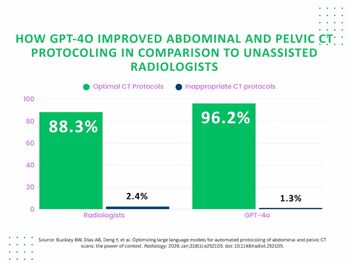
Clinicians' home viewing of images raises concerns
A major benefit of PACS is its ability to communicate digital images and reports to referring physicians quickly and reliably. This almost-instant availability of images to referring physicians, however, often results in the controversial situation of
A major benefit of PACS is its ability to communicate digital images and reports to referring physicians quickly and reliably.
This almost-instant availability of images to referring physicians, however, often results in the controversial situation of clinicians viewing images prior to radiologists' input or review.
"This has become more of an issue with new wavelet compression techniques that allow home viewing by any referring physician with a home computer and Web access," said Dr. William Keyes, a neuroradiologist at Inland Imaging in Spokane, WA.
Some radiologists contend that this new technology takes them out of the loop, while others maintain that the value-added quality of a timely and competent reading is the real product radiologists offer their referring physicians.
"This is a realistic concern," said Dr. Gary Wendt, an assistant professor of radiology at the University of Wisconsin-Madison. "Some institutions have had the attitude that they will not make images electronically available to the enterprise until they have been looked at by a radiologist."
That's not the solution, he said. Instead, radiology needs to tie the urgency of the read to the actual patient care being provided.
Quality of care is not affected if a referring physician sees a routine head or back imaging procedure, done during the evening, before the radiologist reviews it, Wendt said.
Taking the radiologist out of the loop entirely would affect quality of care, however. Numerous studies have shown that radiologists provide additional benefits to reading exams, particularly subspecialist reads, he said.
"While it is sometimes disconcerting to know that a referring physician is viewing 'your' study from home, the expertise a neuroradiologist has to offer in often crucial," Keyes said. "Our CT and MR scanners are monitored 24/7 and the studies are frequently tailored to suit the clinical condition at hand."
The choice of CT angiography in the acute stroke setting, for instance, or the decision to use contrast for MRI must be made by the radiologist on duty, he said.
Radiologists obviously take responsibility for these decisions and should not be uncomfortable with a referring physician who may be viewing the images on a home computer, Keyes said. And it is referring physicians' ability to view images at home that often allies them with radiologists in their negotiations with hospitals to purchase PACS in the first place, he said.
Newsletter
Stay at the forefront of radiology with the Diagnostic Imaging newsletter, delivering the latest news, clinical insights, and imaging advancements for today’s radiologists.




























